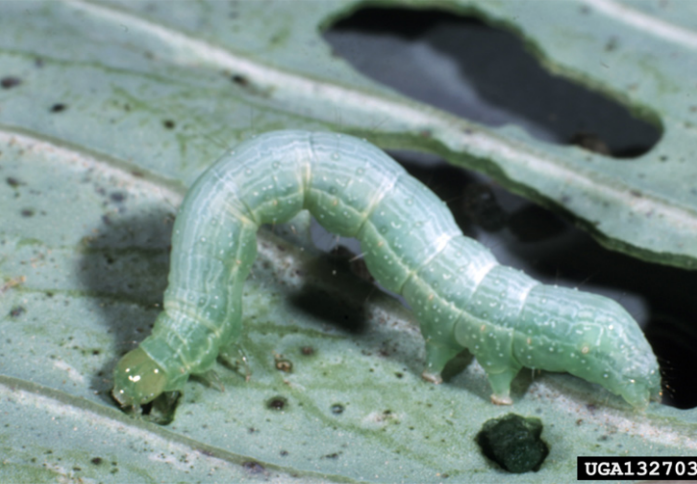Trichoplusia ni (Hübner)
Authors: Alton “Stormy” Sparks, David Riley, University of Georgia, 2021
Description
Immature stages: Eggs are round and flat (0.6 mm wide by 0.4 mm high) with fine ridges from top to bottom. Larvae are light to dark green with a light longitudinal stripe on either side of the body and two pair of abdominal prolegs. The body is thick, tapers toward the head and the larvae crawl in a looping fashion, arching the middle portion of the body. Larvae may reach a length of 35 mm, which makes it one of the larger larvae found on vegetable crops.
Immature stages: Forewings of the cabbage looper adult moth are grayish to dark brown with a silvery spot near the center; hindwings are pale brown. The wingspan is 33-38 mm.


Biology
Cabbage loopers can have up to seven generations in south Georgia each year. Reproduction occurs throughout the year but slows during winter, with lower development temperature threshold between 10-12o C. Annual migrations arise from southern areas in early spring. Eggs are laid singly on the underside of leaves. Larvae feed for two to three weeks and then pupate. High summer temperatures (40o C or greater) can stifle reproduction and can be fatal at some stages of development. Cabbage loopers overwinter in the pupal stage.
Damage
The cabbage looper feeds on a wide variety of cultivated plants and is considered a secondary pest of tomato in Georgia. Cabbage looper readily feeds on crucifers such as broccoli, cabbage, cauliflower, Chinese cabbage, collards, kale, mustard, radish, rutabaga, turnip, and watercress.
Other vegetable crops injured include beet, cantaloupe, celery, cucumber, lima bean, lettuce, parsnip, pea, pepper, potato, snap bean, spinach, squash, sweet potato, and watermelon. Additional hosts are flower crops such as chrysanthemum, hollyhock, snapdragon, and sweet pea, and field crops such as cotton and tobacco. Larval feeding on foliage is usually initiated on mature leaves and can occasionally occur on the surface of mature fruit. Older larvae consume large irregular areas of leaves, characteristically leaving the larger leaf veins. About 90% of total defoliation occurs during the last two larval instars.
Management
Chemical control: Scout weekly to determine if a 5% defoliation threshold has been reached and, if so, treat with an effective insecticide spray. Use insecticides soft on beneficials early in the season to increase beneficial activity and reduce selection for insecticide resistance. Neem oil functions as both a feeding deterrent and growth regulator.
Biological control: Inspect for beneficial natural enemies of cabbage looper including nuclear polyhedrosis virus that causes larvae to collapse, Trichogramma spp. parasitized eggs, and various wasp parasitoids. The bacterium Bacillus thuringiensis kurstacki has long been used for effective suppression of cabbage looper, and has the advantage of not disrupting populations of beneficial insects.
Cultural control: Floating row covers, where economically practical, are effective at preventing cabbage looper moths from depositing eggs on crops.
